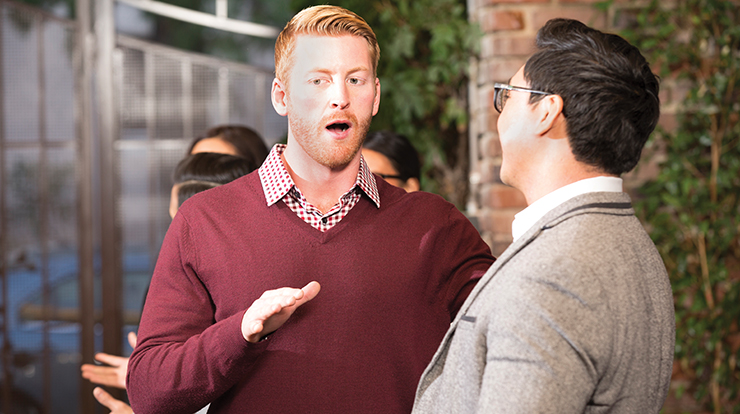
Talking well and conversing well are not the same thing. We often make the mistake of thinking someone is a good conversationalist because they’re funny, witty or tell good stories. But that’s what a stand-up comedian does well, and you’d hardly describe an evening at a comedy show as a conversation.
It’s best to remember what a true conversation is and what it is not. If one person is dominating the conversation—talking about what they’re doing, what they believe or what they know—that’s similar to a lecture. One person is supplying information, and the other person is mostly absorbing that information or tuning out.
A conversation is also not a debate. A debate is an adversarial exchange, even when it’s civil, in which two people are putting forth arguments for opposing sides. While a debate can be productive and informative, it’s not a conversation.
Many so-called “conversations” really consist of two people saying what they know or think. Neither is really listening to the other; they’re often repeating things they’ve said before, and the exchange is focused on each individual’s thoughts, ideas and needs.
Engaged Listening
A conversation is a mutual exchange of ideas. To have a real conversation, you must hear what the other person is saying, think about it and then respond. Sadly, this kind of exchange is not common. We often don’t hear everything someone says. Instead, we listen to the first 5–10 seconds and then stop listening and simply wait for them to stop talking so we can say what we want to say. As notable author and keynote speaker Stephen Covey said, “Most of us don’t listen with the intent to understand. We listen with the intent to reply.”
The most essential component of a good conversation is engaged listening, but it doesn’t come easily. Ralph Nichols, known as the “father of listening,” wrote a piece for the Harvard Business Review with Leonard Stevens in 1957 after years of studying human listening skills and said, “People in general do not know how to listen. They have ears that hear very well, but seldom have they acquired the necessary aural skills that would allow those ears to be used effectively for what is called listening.”
“Imagine conversation as a game of tennis in which you are constantly hitting the ball back to the other side.”
Listening is hard because it requires that you be focused and present. In an era of smartphones and other distractions, it’s difficult to practice mindfulness. But even if your phone never makes a sound, you may be less focused when it’s near because your brain is prepared for it to make noise. Because your brain knows you might receive a text, email or other notification at any time, it may remain on constant alert.
Research shows that typical daily stress can cause your IQ to drop about 10 points because your brain is in fight-or-flight mode most of the day. But the cognitive cost you pay is higher than that. Since that phone causes your mind to be in a constant state of stress, the prefrontal cortex is too busy to help you listen or respond to what you hear during a conversation. The prefrontal cortex is involved with executive decisions, planning, impulse control and complex thought.
So while your phone is visible and keeping your prefrontal cortex busy dealing with stress, you are not making good decisions, planning for the future or controlling your impulses. There’s a good chance your conversation could go awry under those circumstances.
The ‘Liking Gap’
Another obstacle to engaged listening is our own fear. For some time, social scientists have struggled to understand why we avoid in-person contact and face-to-face conversations. As a social species, conversation is beneficial for us. Regular in-person socialization can extend your lifespan, strengthen your immune system and stave off depression and heart disease. So why would people stare at their phones on the subway and avoid making eye contact with others?
When researchers forced people to start conversations with strangers on trains, in waiting rooms and at coffee shops, the participants ended up enjoying themselves. They also reported they were no less productive than if they’d kept to themselves. And yet, when these subjects were asked if they would start more conversations in the future, most answered no. Why?
As it turns out, we get in the way of our own enjoyment and well-being. A recent study showed that oftentimes, we are so caught up worrying about saying the right thing or being witty, we don’t notice that the other person is enjoying our company. This is called the “liking gap” and it means we tend to significantly underestimate how much other people like us. We’re stuck in our own heads, afraid we will say the wrong thing.
While we obsess about what we’re saying and how we’re coming off, we don’t have time to really pay attention to what another person is saying. Sadly, this is also what prevents us from engaging in conversation in many circumstances: our fear that we’ll say the wrong thing or be judged negatively by the other person. That means the first step to listening well and enjoying a good conversation is to let go of your fear. Rest assured that the vast majority of conversations you have, whether they be with a loved one or an acquaintance, will lift your mood, engage your mind productively and improve your health.
Finding Balance
The next step is to allow the other person to speak as often as you do. Keep in mind that you can’t control other people’s behavior. That means you can’t prevent them from talking too much, interrupting you or rambling on about irrelevant subjects. Therefore, it’s best not to expend mental energy worrying about someone else’s conversational etiquette and instead focus on what you can control—namely, your own habits.
Pay attention to how often you allow the other person a chance to respond. The best conversations resemble a friendly game of catch, in that there’s a perfect balance between throwing and catching. Attention spans have been shrinking for at least the past two decades, so if you talk for more than 30 seconds at a time, it’s likely you’ve lost the other person’s focus. Help them stay engaged and remain focused by keeping it brief. An easy way to do that and to ensure what you’ve said will be understood and remembered is to talk about one thing at a time. Many of us are in the habit of telling everything we know on a subject or telling too many stories.
“Most of us don’t listen with the intent to understand. We listen with the intent to reply.” —Stephen Covey
If someone asks what you did over the weekend, don’t start with Friday afternoon and give them all the details you can remember. Instead, give the bullet points and then allow them to respond. Alternatively, you could focus on one aspect: “We went paddling on Saturday. We were on the water for about four hours, and it was really fun. There were four of us, and we each had our own kayak. Brandon forgot sunscreen and got burned, but it was a great day.” That story takes about 20 seconds to tell and, if you stop there, it’s likely the other person will have some questions.
Imagine conversation as a game of tennis in which you are constantly hitting the ball back to the other side. Remember that you already know everything you’re going to say and, if you’re going to learn something new, you’re going to have to listen to someone else. 
Celeste Headlee is an award-winning journalist, public radio host, speaker and expert in communication. Through her work, she has interviewed hundreds of people from all walks of life, learning the power of conversation. Celeste authored the book We Need to Talk: How to Have Conversations That Matter. Learn more at www.celesteheadlee.com.
Related Articles

Communication
Become a Better Conversationalist

Club Experience
How to Muzzle the Yakker

Communication



 Previous
Previous
 Previous Article
Previous Article